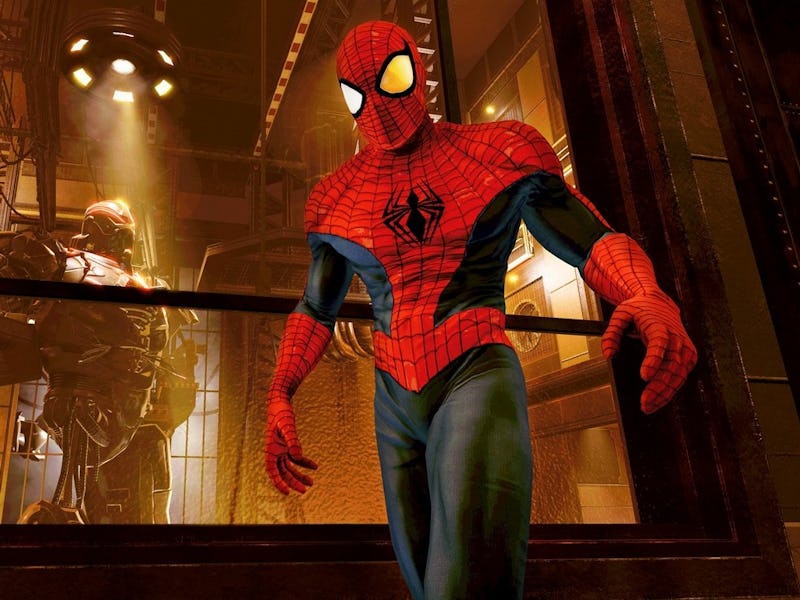Not even Batman can save the worst Spider-Man game of the last decade
Val Kilmer plays the villain in one of the worst Spidey games ever.

One of the best animated films ever made owes its existence to a Spider-Man video game. So why doesn’t anybody ever talk about what came next?
In 2010, the Activision-owned Canadian studio Beenox released Shattered Dimensions, which proved audiences could handle the multiverse and directly inspired Spider-Man: Into the Spider-Verse. But a year later on October 4, 2011, Beenox followed up that success with Edge of Time, a PC, PS3, and Xbox 360 title that quickly fell into obscurity.
Upon revisiting Spider-Man: Edge of Time, it’s apparent this isn’t some forgotten gem. Instead, it’s the weirdest AAA Spider-Man game of all time and one that demonstrates all of the worst ways to make a Peter Parker experience.
We’re currently in a golden age of Spider-Man media, with the upcoming live-action Spider-Man: No Way Home film premiering later this year, an animated Spider-Verse 2 in the works, and Marvel’s Spider-Man 2 game from Insomniac also on the horizon.
With so many Spidey sequels in development, there’s never been a better time to learn a valuable lesson about what not to do from Spider-Man: Edge of Time.
Far From Home — As its name suggests, Shattered Dimensions was a dimension-hopping romp, but Edge of Time fails to recapture that magic. The sequel follows Amazing Spider-Man and Spider-Man 2099 as they work together in the past and future to fix a timeline broken by an Alchemax scientist voiced by Val Kilmer.
Yes, that’s right, Val Kilmer (aka, Batman) was in a Spider-Man video game.
Val Kimler plays an evil scientist in Edge of Time.
Kilmer’s Walker Sloan messes with the timeline by traveling back in time and founding his evil corporation Alchemax years before it’s supposed to exist. It’s an intriguing premise, but it fails to have an emotional narrative like Marvel’s Spider-Man or a fun story like Shattered Dimensions.
Edge of Time drops trades charm for a serious story stuck in drab grey, black, and blue environments. The Spider-Mans (Spider-Men?) are constantly bickering and shouting fake swear words to maintain a Teen rating.
The best Spider-Man stories tap into the character’s relatability or serve as showcases for the comic’s memorable pantheon of characters. Edge of Time settles for gruff Spider-Man and generic villains.
Instead, Edge of Time poorly capitalizes on the playable Spider-Men concept that Shattered Dimensions kickstarted without understanding why that worked in the first place. What the first game did best was embrace the charm of each dimension while demonstrating a passion for popular and obscure parts of Spider-Man’s storied history. Edge of Time has none of that.
This is an issue that Spider-Verse 2, in particular, will have to grapple with as it follows up one of Spider-Man’s most relatable adventures. Hopefully, it doesn’t drop the ball like Edge of Time.
Spider-Man: Into the Spider-Verse (2018).
Succumbing to Scope — A lack of ambition also lets down Edge of Time. Yes, it’s dealing with two Spider-Men and complicated time travel concepts, but its setting is extremely limited. The entirety of this game takes place inside one building, which is a disservice to such an athletic and acrobatic character. This feels especially disappointing after Insomniac’s Spider-Man games nailed the satisfying feel of web-swinging around New York City.
The gameplay is lame, riffing on old-school God of War-inspired beat ‘em ups that were all too common in the waning years of the Xbox 360 and PS3 generation. Edge of Time’s only novel idea is the “cause and effect” system, where players can change the future by building or destroying something in the past.
It’s pretty contextual, but the brief moments when you play both Spider-Men back-to-back and change the environment as you go are the standout setpieces. If a more puzzle-focused or larger game had the time to tackle this concept, it could’ve been great. Instead, it only pops up occasionally throughout the game’s meager 4-5-hour runtime.
Each Spider-Man has unique combat abilities, but none are much more useful than button-mashing.
Overall, Edge of Time suffers from feeling like a rushed sequel. As a result, it lacks the passion and charm of the original, and even Val Kilmer can’t save that. Edge of Time is much more high-concept than it needed to be, but this action game ultimately feels more like a cash grab with a couple of intriguing ideas.
Edge of Time is an oddity in the wall-crawler’s video game history, but it’s worth seeking out a used copy if you want to see what exactly can go wrong with a follow-up to a Spider-Man experience. It’s been delisted from digital storefronts for a while, so you will have to find a physical copy.
Whenever Spider-Man media tries to play it safe, the results are disappointing. Spider-Man 3 and The Amazing Spider-Man 2 similarly dropped the ball, and Sony runs the risk of repeating past mistakes if it rushes any of its Spidey sequels.
Nobody talks about Spider-Man: Edge of Time in 2021 because it’s a forgettable failure. These upcoming Spider-Man sequels deserve a better fate than that.
This article was originally published on